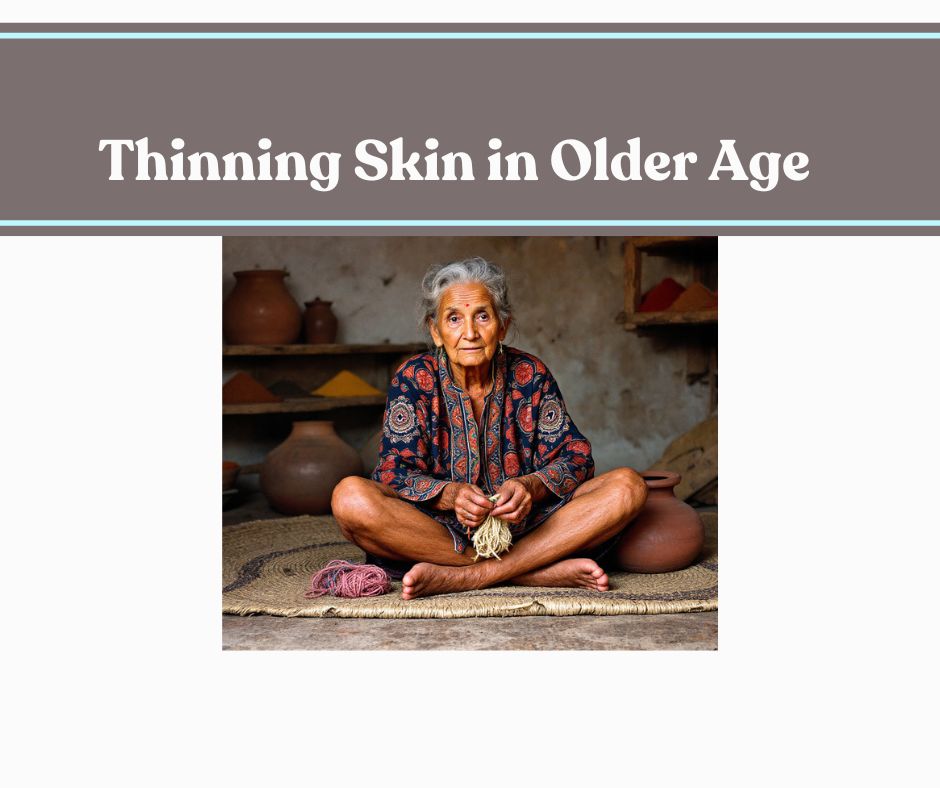
Management of Thinning Skin in the Older Age!
Understanding Thinning Skin...
As we age, our skin naturally loses collagen, elasticity, and moisture, making it thinner, more fragile, and prone to issues like dryness, itching, bruising, and slow healing. This is a common concern, especially on the legs, arms, and hands, where the skin is more exposed and vulnerable.

Causes of Thinning Skin in Older Age
- Loss of Collagen and Elastin – As people age, their skin produces less collagen and elastin, leading to reduced strength, elasticity, and thickness.
- Reduced Fat Layer – The subcutaneous fat layer beneath the skin becomes thinner, making the skin more fragile and prone to injuries.
- Decreased Sebum Production – The skin produces less natural oil, leading to dryness, flakiness, and increased sensitivity.
- Poor Circulation – Conditions like peripheral artery disease (PAD) and diabetes can impair blood flow to the skin, reducing its ability to heal.
- Chronic Sun Exposure (Photoaging) – UV damage accumulates over time, breaking down collagen and making the skin weaker.
- Medication Side Effects – Long-term use of corticosteroids (topical or oral), blood thinners, and some chemotherapy drugs can lead to thinning skin.
- Underlying Medical Conditions – Conditions like diabetes, malnutrition, or chronic kidney disease can contribute to poor skin health.

Common Symptoms
- Itchiness (Pruritus) – Due to dryness and inflammation.
- Flakiness and Scaling – A result of decreased oil production.
- Easy Bruising and Tearing – Even minor friction can cause skin damage.
- Slow Healing – Small cuts or breaks in the skin can take longer to heal, increasing the risk of infections.
- Ulcer Formation – If the skin breaks and does not heal properly, it can develop into chronic wounds, particularly in individuals with poor circulation.

Potential Complications
- Infections – Bacteria can enter through skin breaks, leading to cellulitis or deeper infections.
- Venous Stasis Ulcers – Common in those with venous insufficiency (poor blood flow from the legs).
- Pressure Sores (Bedsores) – If mobility is reduced, pressure can cause skin breakdown.
- Eczema – A severe form of dry skin with deep cracks that can bleed.

Prevention and Management
Hydration & Moisturization
- Use thick emollients like body butters containing natural oils such as coconut oil and shea butter to lock in moisture.
- Avoid hot water and harsh soaps that strip natural oils.
Gentle Skin Care
- Use fragrance-free, hypoallergenic cleansers.
- Pat the skin dry instead of rubbing.
- Wear loose, soft clothing to prevent irritation.
Improve Circulation
- Elevate legs when sitting.
- Engage in mild leg exercises to promote blood flow.
- Consider compression stockings (if recommended by a doctor).
Protect the Skin
- Avoid trauma (e.g., bumping into furniture).
- Use soft, padded socks and footwear.
- Keep nails trimmed to prevent accidental scratches.
Treat Itchiness Carefully
- Apply moisturizing natural body butters that are preservative & fragrance free.
- Use antihistamines if itching is severe (under medical supervision).
- Avoid scratching, as it increases the risk of infection.
Medical Interventions
- If skin ulcers or infections develop, seek medical attention promptly.
- For chronic non-healing ulcers, treatments like wound dressings, antibiotics, or skin grafting may be necessary.
When to See a Doctor
- If there are non-healing wounds or signs of infection (redness, warmth, pus, swelling).
- If skin becomes extremely fragile, painful, or bruises easily.
- If there is severe itching or discomfort interfering with sleep and daily life.

Would you like specific product recommendations for managing thinning skin? Please do not hesitate to contact us for more information.
